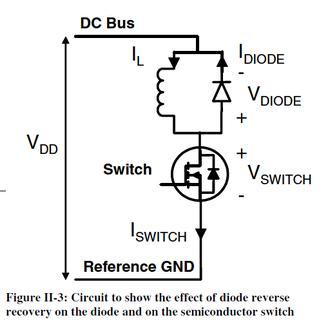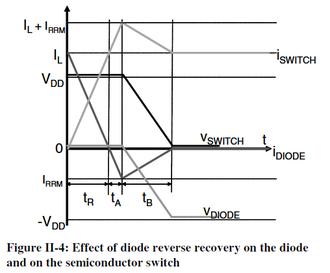فک میکردم که دیود دیگه داستان نداره و همین یه زمان روشن شدن و جریان و دراپ و جریان نشتی و ایناس فقط که یهو فهمیدم یه جا یه دیود اسنابر بعلت "جریان ریورس ریکاوری" میسوزه!!که رسیدیم به این داستان ها:
خب دیود های غیر شاتکی ساختارشون این مدلیه: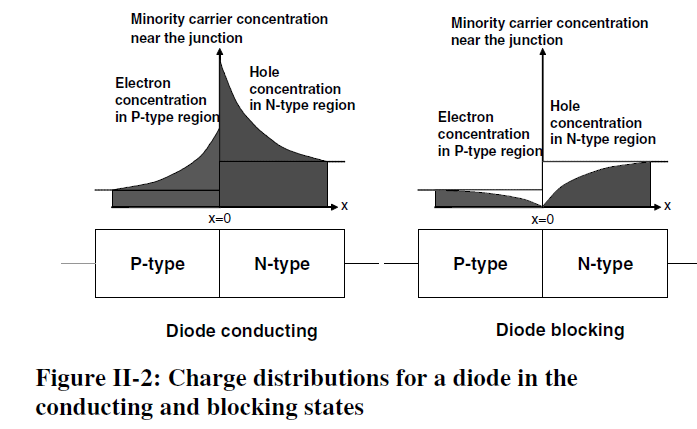
یعنی برای این که روشن بشن حامل های جریان(الکترون ها و حفره ها) میان دور مرز ناحیه pn جمع میشن.این باعث میشه زمانی که سر روشن کردن و خاموش کردن یه جریانی صرف تغییر وضعیت این حامل ها بشن که توی زمان خاموش شدن به اصطلاح جریان ریورس ریکاوری نامیده میشه و اگه یه موقع بخوایم با زور دیود رو خاموش کنیم باعث ایجاد مقداری تلفات میشه.
بعنوان مثال این مدار سمت راست رو در نظر بگیرید زمانی که ما سوییچ رو روشن میکنیم خب در واقع دیود رو خاموش میکنم و نمودار جریان و ولتاژ بالا (زمان صفر زمانی هس که ولتاژ گیت از ولتاژ تریشلد رد شده و روبه زیاد شدن هس). اون اور کارنتی که جریان سوییچ نسبت به جریان کاریش داره لحظه ای که میرسه به جریان کاریش، بخاطر وجود دیود هست و در واقع بخاطر جریان ریورس ریکاوری دیود.نتیجتا جریان ریورس ریکاوری باعث بیشتر شدن تلفات سوییچ میشه که توی طراحی باید در نظر گرفته بشه. اون پیک جریان ریورس دیود Irr نامیده میشه که توی دیتاشیت هم میاد و بعضا میتونه از جریان نامی دیود هم بیشتر بشه! این جریان Irr با افزایش دما یا افزایش di/dt و یا افزایش خود جریان کاری، افزایش پیدا میکنه.(همچنین زمان ریورس ریکاوری هم با افزایش دما افزایش پیدا میکنه.جالبه بدونید راپ دیود با افزایش دما کاهش پیدا میکنه)
خب به ترتیب تلفات روشن شدن دیود، روشن شدن ماسفت زمانی که دیود هم هست تو مدار، و زمانی که دیود نیست تو مدار، تلفات اضافی سوییچ که بخاطر وجود دیود هست، اخری هم یه شکل دیگه از فرمول تلفات سوییچ زمانی که دیود نیست.
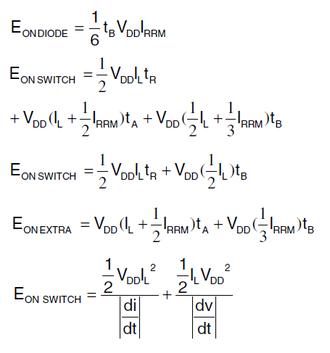 اگه توی فرمول تلافت اضافی ناشی از دیود نگاه کنید میبینید توی زمان ta یه جریان باعث اتلاف میشه و توی زمان tb یه جریان دیگه(کمتر و مساوی جریان زمان قبلی) باعث وجود تلاف میشن.توی دیود های فست tb خیلی کمتر از ta میشه که در نتیجه برای یه زمان ریورس ریکاوری ثابت دیود فست تلفات مسیر مدار رو بیشتر میکنه اما تلفات روشن شدن دیود که همون معادله اول هست کم میشه.
اگه توی فرمول تلافت اضافی ناشی از دیود نگاه کنید میبینید توی زمان ta یه جریان باعث اتلاف میشه و توی زمان tb یه جریان دیگه(کمتر و مساوی جریان زمان قبلی) باعث وجود تلاف میشن.توی دیود های فست tb خیلی کمتر از ta میشه که در نتیجه برای یه زمان ریورس ریکاوری ثابت دیود فست تلفات مسیر مدار رو بیشتر میکنه اما تلفات روشن شدن دیود که همون معادله اول هست کم میشه.
خب لازم به ذکره که بگم با افزایش جریان نامی دیود جریان ریورس ریکاوری زیاد میشه و با زیاد شدن ولتاژش جریان ریورس ریکاوری کم میشه!
البته خب این برای دیود های سریع تر تاثیرش کم میشه و همون طور که گفتم افزایش دما تاثیر خیلی بیشتری روش داره تا این پارامترها...
و گفتیم هم که با افزایش di/dt هم زمان و هم جریان ریورس ریکاوری زیاد میشن در حالی که تلفات ماسفت کم میشن...اصن اوضاعیه ...
اینم خلاصه این مقاله ای که بیشتر ازش استفاده کردم:
CONCLUSION
Reverse recovery in diodes introduces small
losses in the diode but larger losses in the MOSFET
or IGBT which is switching the diode. These losses
are influenced by the two reverse recovery
parameters IRRM and tRR.
From a system design perspective, there are three
aspects influencing the optimization of a half-bridge
structure: di/dt, diode choice and the possible
inclusion of a parallel capacitor.
Higher di/dt results in lower EON losses in the
circuits tested, noting that higher di/dt increases
IRRM losses less than it decreases the normal
switching losses. So from perspective of switch and
diode losses, increasing di/dt is beneficial despite
the increase in IRRM.
The use of fast recovery diodes improves
switching losses, but generally worsens conduction
losses. Larger current rated diodes of the same
family have higher IRRM resulting in higher EON, and
a larger capacitance, resulting in lower EOFF. Overdimensioning
of the diodes is not recommended as
this leads to higher total switching losses.
Addition of extra capacitance increases EON losses
but decreases EOFF losses. There is the possibility
that an optimum total loss point will exist, meaning
that the addition of extra capacitance will reduce
total losses. Designers of circuits using half-bridges
should consider this possibility in their applications:
inclusion of a low cost capacitor may help improve
efficiency.
اینم یه عکس خلاصه از مقایسه دیود های با ساختار متفاوت: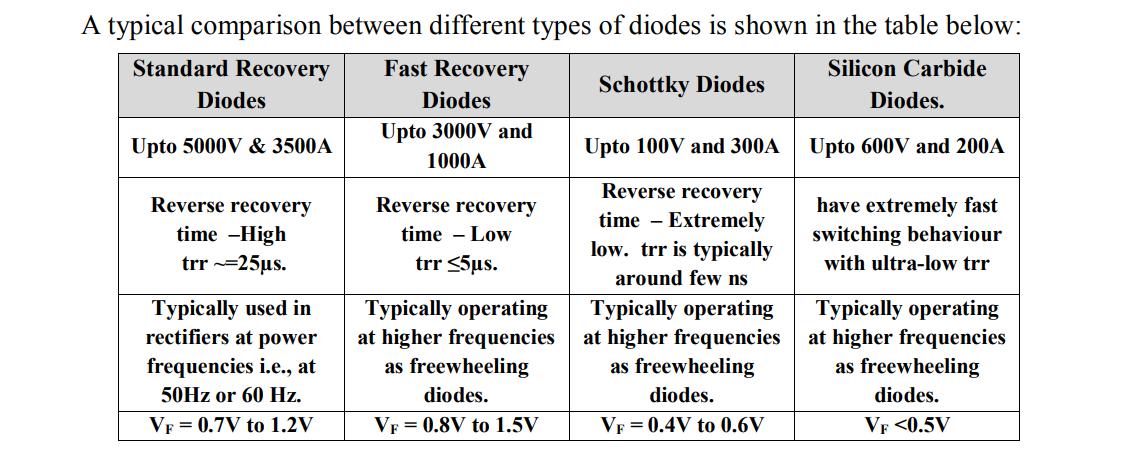
باشد که رستگار شویم...:)

